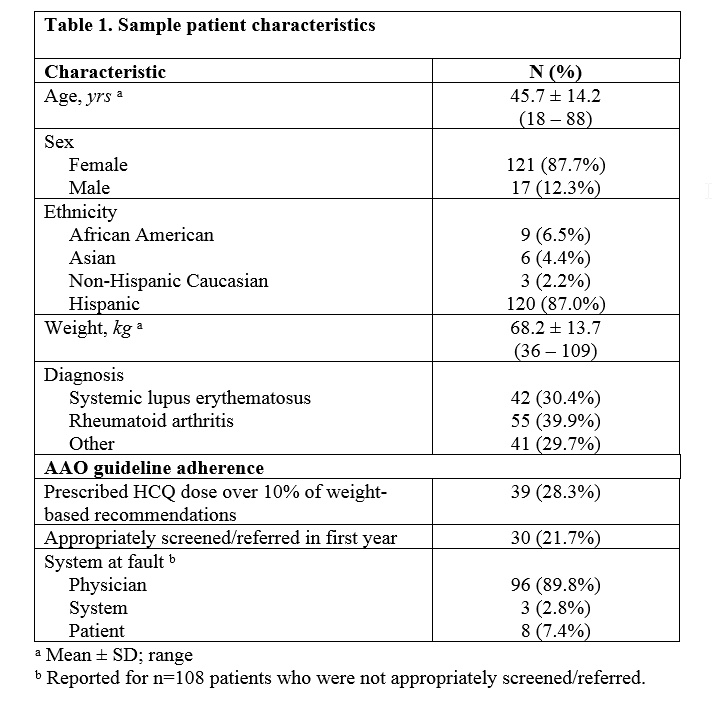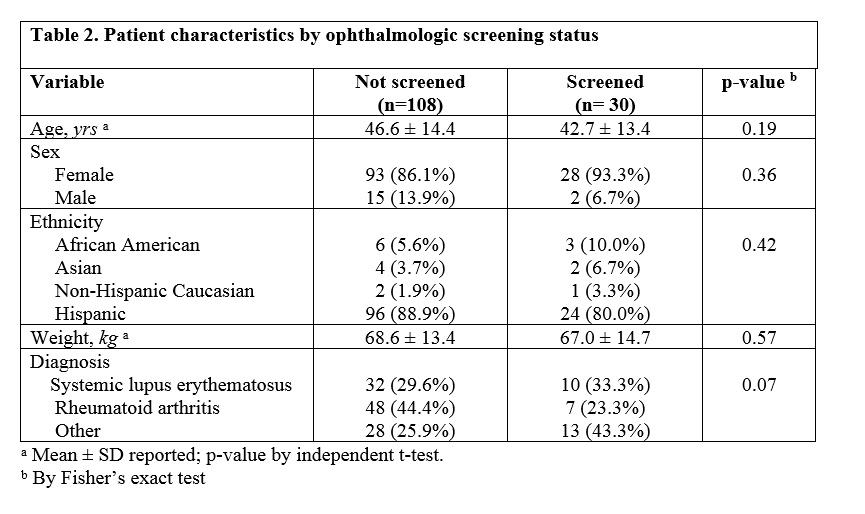Session Information
Date: Sunday, November 7, 2021
Title: Measures & Measurement of Healthcare Quality Poster (0623–0659)
Session Type: Poster Session B
Session Time: 8:30AM-10:30AM
Background/Purpose: Hydroxychloroquine (HCQ) is used in many rheumatologic diseases. The American Academy of Ophthalmology (AAO) put forth guidelines in 2012 regarding retinal screening and dosing of HCQ. These include a retinal exam in the first year after initiation of HCQ and a maximum dose of 5mg/kg/day of actual body weight. The Los Angeles County + University of Southern California Medical Center (LAC+USC MC) serves a largely underinsured urban population. LAC+USC MC utilizes an online third-party system for ophthalmology referrals. Our aim is to evaluate the LAC+USC MC rheumatology clinic’s effectiveness at pursuing ophthalmologic care for HCQ patients and adhering to the appropriate dosing recommendations put forward by the AAO. Using this data, we plan to evaluate the effectiveness of a HCQ dosing calculator in increasing adherence to appropriate dosing recommendations.
Methods: First, a retrospective chart review was performed of rheumatology clinic patients prescribed HCQ in the LAC+USC MC rheumatology clinic. Charts of patients with clinic visits between March 2018 and May 2018 were reviewed. Patients were included if they had a clear first-time HCQ initiation date. Following the retrospective chart review, a HCQ dosing calculator was implemented into the EMR in March 2020 that is prompted to appear whenever a patient is prescribed HCQ for the first time. Charts of patients prescribed HCQ between March 2020 and September 2020 were reviewed. Patients were included if they had a clear first-time HCQ initiation date after March 2020, a documented weight, and a clear HCQ daily dose. Prescribed dose and recommended weight-based dose of HCQ were noted.
Results: One hundred and thirty-eight patients qualified for analysis in the initial retrospective chart review. Of the 138 patients, 30 (21.7%) received ophthalmologic assessment within the first year of HCQ use. Of the remaining patients who were not screened, 97 patients (89.8%) lacked a timely referral to ophthalmology. Thirty-nine (28.3%) patients were prescribed a HCQ dose higher than the AAO guidelines; the average amount in excess of the recommended dose was 24.3% (range 1-122%). Following implementation of the HCQ dosing calculator, forty-four patients qualified for analysis. Of these included patients, zero patients were prescribed a HCQ dose higher than the AAO guidelines.
Conclusion: Our findings demonstrate that providers are not meeting the guidelines for ophthalmologic screening when prescribing HCQ. Additionally, a large proportion of our patients are prescribed more than the recommended HCQ dose. We implemented a HCQ dosing calculator in order to address difficulty with individualized dosing as well as a lack of knowledge about the guidelines. The calculator was very successful in lowering the proportion of patients prescribed more than the recommended HCQ dose, with zero patients being inappropriately dosed after calculator implementation. We believe this promising method warrants further study and should be considered in other institutions. In the future we plan to address HCQ retinal screening deficiencies by educating providers on AAO guidelines and working with third party referral systems to ensure ease of referrals.
To cite this abstract in AMA style:
Cerk B, Toy B, Situ B, Savvas S, Wise L. Adherence to Hydroxychloroquine Dosing and Teleretinal Screening: Assessment and Quality Improvement [abstract]. Arthritis Rheumatol. 2021; 73 (suppl 9). https://acrabstracts.org/abstract/adherence-to-hydroxychloroquine-dosing-and-teleretinal-screening-assessment-and-quality-improvement/. Accessed .« Back to ACR Convergence 2021
ACR Meeting Abstracts - https://acrabstracts.org/abstract/adherence-to-hydroxychloroquine-dosing-and-teleretinal-screening-assessment-and-quality-improvement/


